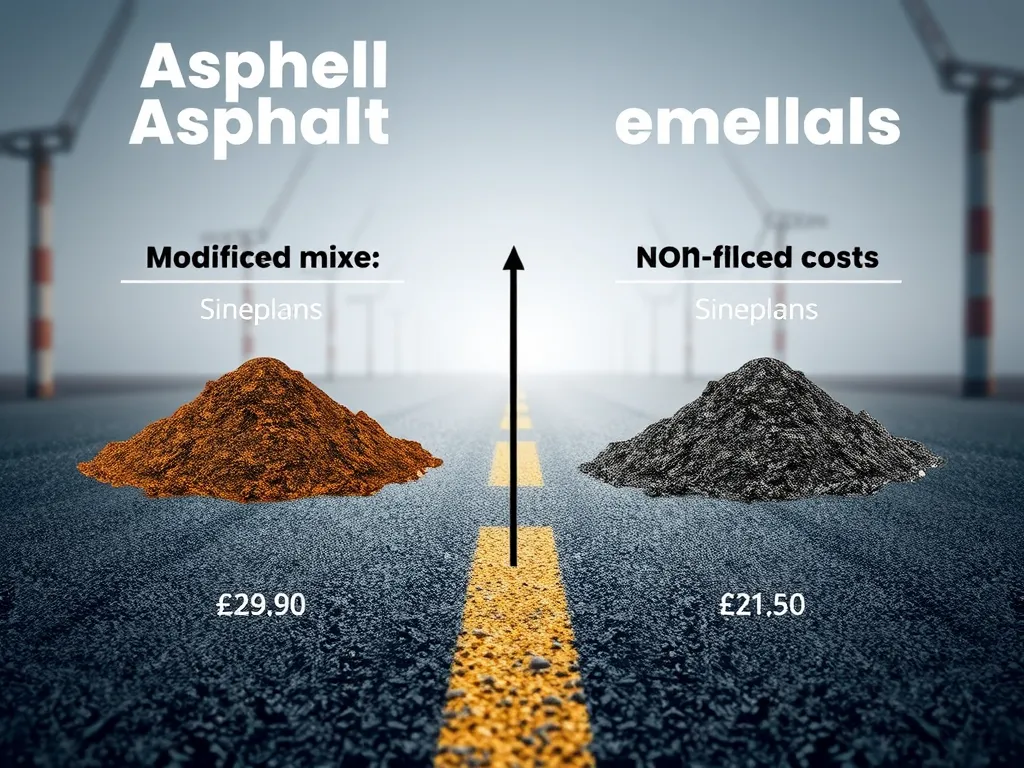Cold Mix Asphalt Formulation Variations: What Makes Each Mix Unique?
Published on: October 17, 2025 | Last Updated: April 14, 2025
Written By: George Voss
Cold mix asphalt formulation variations use different combinations of asphalt binders, aggregates, and additives to create ready-to-use paving materials that harden without heat. Unlike hot mix asphalt requiring high temperatures, these blends rely on emulsified asphalt (water-based) or cutback asphalt (solvent-based) to bind materials at ambient temperatures. Key differences include curing speed (slow-setting vs. rapid-setting emulsions), recycled content levels (up to 100% RAP in some mixes), and durability enhancements (polymers or wax additives). Specific formulas excel in distinct scenarios—rapid-setting patches fix potholes in 2 hours, while high-RAP blends reduce material costs by 30-40% for low-traffic roads.
This article breaks down how cold mix formulas work for different jobs. Learn how emulsion types compare to cutback asphalt in cost and environmental impact. Explore polymer-modified mixes that handle heavier traffic and specialty blends for extreme climates. Get data on curing times, strength ratings, and real-world uses from driveway repairs to road construction. We’ll also cover recycling innovations and which formulas give the best ROI for your project.
Contents
- Core Components Of Cold Mix Asphalt Formulations
- Key Variations in Cold Mix Asphalt Formulations
- Performance Specifications for Cold Mix Asphalt
- Comparing Formulation Variations
- Targeted Applications Of Formulation Types
- Environmental Considerations in Formulation Design
- Cost-efficiency Of Different Formulations
- FAQs: Cold Mix Asphalt Formulation Variations
- Closing Thoughts
- Additional Resources for You:
Core Components Of Cold Mix Asphalt Formulations
Cold mix asphalt formulations rely on precise combinations of materials to balance workability, strength, and weather resistance. Three elements form the backbone of every mix.
Essential Ingredients in Cold Mix Asphalt
Every cold mix asphalt variation starts with these foundational components. Adjusting their ratios or types creates distinct performance profiles.
Asphalt Binders (Emulsified or Cutback)
Binders glue aggregates together. Emulsified asphalt blends bitumen with water and surfactants (like soap), creating workable mixtures that cure as water evaporates. Cutback asphalt uses solvents (kerosene or diesel) to thin the bitumen, hardening as solvents dissipate. Emulsions dominate modern mixes due to lower VOC emissions (under 50 ppm vs. 200+ ppm for cutbacks).
Aggregates and Gradation Requirements
Aggregates provide structural stability. Gradation—the size distribution of crushed stone or gravel—affects compaction and load-bearing capacity. Most cold mix formulas use angular aggregates sized between 3/8″ and #4 sieve (per ASTM D692). Fine aggregates (like sand) fill voids, while coarser stones boost rut resistance.
Additives and Modifiers
Additives fine-tune performance. Polymers (SBS or latex) enhance flexibility in freezing temps. Fibers (cellulose or polyester) reduce cracking. Anti-stripping agents (hydrated lime) prevent moisture damage. Some mixes include 0.5-2% cement for faster curing or 5-10% RAP (recycled asphalt pavement) to cut costs.
These core components set the stage for cold mix asphalt variations. Next, we examine how adjustments to binders, aggregates, or additives create mixes tailored for specific needs.
Key Variations in Cold Mix Asphalt Formulations
Cold mix asphalt formulations differ based on binder types, modifiers, and recycled content. These variances directly impact performance, curing times, and project suitability. Let’s explore the primary formulation categories.
Emulsified Asphalt Mixtures
Emulsified mixes combine liquid asphalt with water and surfactants. These formulations bond with existing pavement without heat, making them ideal for quick repairs.
Standard Emulsion Formulations
Standard blends use 60-70% asphalt content with 0.5-2% emulsifying agents. Typical gradation follows ASTM D2397 specs, using aggregates sized between 3/8″ and #200 sieve. These work for most temporary patches requiring 4-8 hour curing.
Slow-Setting vs. Rapid-Setting Emulsions
| Type | Cure Time | Use Case | Binder Content |
|---|---|---|---|
| Slow-Setting (SS) | 12-24 hours | Deep patching | 6-8% |
| Rapid-Setting (RS) | 1-3 hours | Surface repairs | 4-6% |
Slow-setting emulsions penetrate deeper layers due to delayed water evaporation. Rapid-setting versions employ higher surfactant doses for fast traffic reopening.
Cutback Asphalt Formulations
Cutbacks dissolve asphalt in petroleum solvents like naphtha or kerosene. These formulations suit colder climates where emulsions might freeze.
Solvent-Based Composition Variations
| Type | Solvent | Evaporation Rate | Min Temp |
|---|---|---|---|
| RC (Rapid-Curing) | Naphtha | 15-40 min | 40°F |
| MC (Medium-Curing) | Kerosene | 2-4 hours | 25°F |
RC cutbacks work for spray applications, while MC types handle stockpile mixes. Solvent content ranges from 10-30% by weight.
Polymer-modified Cold Mix Formulas
Adding polymers like SBS or latex boosts tensile strength by 30-50%. These mixes withstand heavier loads, with rutting resistance exceeding 5,000 passes in wheel tracking tests.
Enhanced Durability Formulations
Premium blends incorporate 3-5% crumb rubber or plastomers. These achieve Marshall Stability values over 1,500 lbs, rivaling hot mix performance in freeze-thaw cycles.
Specialty Cold Mix Asphalt Variations
Innovative formulas address niche needs like high recycling rates or extreme temperatures.
High-RAP (Recycled Asphalt Pavement) Blends
Advanced mixes integrate up to 50% RAP with rejuvenators like soybean oil. These meet AASHTO M323 specs while cutting material costs by 18-22%.
Wax-Modified Cold Mixes
Adding 2-4% synthetic wax (e.g., Sasobit) lowers mixing temps by 30°F. Wax-modified formulas achieve 90% compaction at 20°F versus standard mixes needing 40°F minimum.
With these formulation options established, let’s examine how performance specs guide selection for specific climate conditions and traffic demands.

Performance Specifications for Cold Mix Asphalt
Cold mix asphalt formulations must meet strict performance benchmarks to ensure structural integrity under real-world conditions. These specifications dictate material selection, blending ratios, and application protocols.
Strength and Durability Requirements
Marshall Stability values typically range between 500-1,500 pounds-force for cold mixes, depending on traffic loads. Dense-graded aggregates with 3-5% air voids optimize load distribution. Polymer-modified formulas boost tensile strength by 20-40% versus standard emulsions, critical for freeze-thaw resistance.
Curing Time Standards
Curing durations vary from 24 hours to 14 days based on binder type:
| Binder Type | Full Cure Time |
|---|---|
| Slow-setting emulsion | 5-14 days |
| Rapid-setting emulsion | 24-72 hours |
| MC-30 cutback | 7-10 days |
Ambient temperatures below 50°F can double curing times for emulsified mixtures.
Climate-specific Formulation Criteria
Regional weather patterns drive adjustments in cold mix asphalt variations. Thermal cycling ranges dictate binder viscosity grades and modifier packages.
Hot Weather Adaptations
In regions exceeding 90°F, slow-setting emulsions with 60-70% residual binder content prevent premature curing. Crumb rubber additives (8-12% by weight) reduce rutting in high-temperature zones.
Cold Weather Adjustments
Cutback formulations using MC-3000 solvents work below freezing points. Aggregates pre-coated with 2-3% calcium chloride resist ice formation. Viscosity modifiers keep mixes workable down to -10°F during placement.
These performance parameters shape how engineers select between cold mix asphalt emulsified asphalt mixtures versus solvent-based options. Next, we’ll examine how different mix formulas for cold asphalt stack up in direct comparisons.
Also See: Choosing the Right Asphalt Mix for Commercial Use
Comparing Formulation Variations
Cold mix asphalt formulations adapt to project needs through material science. Two primary axes of variation dictate performance: binder type and additive integration.
Emulsified Vs. Cutback Asphalt Mixtures
Binder selection splits cold mix asphalt into two camps. Emulsified blends suspend bitumen droplets in water. Cutback formulas thin bitumen with solvents like kerosene.
Application Differences
Emulsion-based mixes work at 50°F-85°F. They bond through water evaporation, ideal for pothole repairs in moderate climates. Cutback blends need warmer temps (60°F-95°F) for solvent evaporation, speeding up curing by 30-50% in arid zones.
Environmental Impact Comparison
Cutback releases 4.8 lbs of VOCs per ton during curing. Emulsions emit 0.3 lbs. Six states ban cutbacks outright. Emulsified formulas now dominate 78% of municipal repair projects.
Modified Vs. Non-modified Cold Mix Formulas
Polymer additives transform basic cold mix asphalt. SBS rubber boosts flexibility. Lime additives improve moisture resistance. Plain formulas rely solely on bitumen-aggregate bonds.
Cost vs. Performance Tradeoffs
Non-modified mixes cost $35-$45/ton. Polymer-enhanced versions hit $52-$68/ton but last 3-5 years versus 1-2 years. High-traffic areas (250+ ADT) require modified blends to prevent rutting within six months.
Formulation choices ripple through project planning. Next, we examine how these material variations translate to specific paving scenarios.

Targeted Applications Of Formulation Types
Cold mix asphalt formulations adapt to specific use cases through precise adjustments in binders, aggregates, and modifiers. Each variation targets distinct performance needs across pavement scenarios.
Pothole Repairs and Pavement Patching
Rapid-setting emulsion cold mix asphalt formulas dominate pothole fixes. These asphalt emulsion mixtures blend slow-evaporation solvents (like diesel or kerosene) with polymer-modified binders to stay workable at 40°F-100°F. A typical cold mix asphalt variation for patching uses 4-6% MC-30 emulsion with 3/8″ angular aggregates, achieving 300-400 psi stability within 24 hours. High-RAP blends now incorporate 30-50% recycled material without compromising grab strength.
Low-traffic Road Construction
Non-modified cold asphalt mixtures serve rural roads with under 500 vehicles daily. Gradation focuses on 1/2″ maximum aggregate size with 5-7% CSS-1 emulsion. These road asphalt formulations prioritize compaction over curing speed, reaching 90% density at 72°F within 48 hours. Wax-modified cold mix asphalt variations extend workability in cooler climates, maintaining viscosity down to 25°F during placement.
Shoulder Maintenance and Edge Support
Shoulder mixes require erosion-resistant emulsified asphalt formulations. Polymer-modified emulsion cold mix asphalt (PMCM) uses 2% SBS elastomers to boost tensile strength by 40% versus standard mixes. Aggregate gradation shifts to 60-70% passing the #4 sieve, creating a dense matrix that sheds water. Lime additives (1-2% by weight) combat stripping in high-moisture zones, critical for edge durability.
Temporary Driveways and Pathways
Budget-driven cold mix asphalt formulas dominate temporary installations. High-solvent cutback blends (RC-250) cure faster than emulsions, achieving walk-ready surfaces in 4-6 hours. These asphalt cold mix formulas use 50% RAP content with 8-10% MC-3000 emulsion, cutting material costs by 35% versus virgin mixes. Gravel equivalence ratings stay below 0.5, sufficient for foot traffic and light vehicles.
Selecting the right cold mix asphalt formulation demands balancing cure time, load capacity, and site conditions. These application-specific blends set the stage for examining their environmental footprint – a key factor in modern pavement design.
Environmental Considerations in Formulation Design
Cold mix asphalt formulations now prioritize balancing functionality with planetary impacts. Production methods and material choices directly affect air quality, resource use, and infrastructure longevity.
Volatile Organic Compound (VOC) Reduction
Cutback asphalt formulations historically relied on solvents like diesel or naphtha, releasing up to 30% more VOCs than hot mix asphalt. Modern shifts favor cold mix asphalt emulsified asphalt mixtures, using water as a carrier. Slow-setting cationic emulsions cut solvent content by 60-80% while maintaining workability. Some states now restrict cutback use in road asphalt formulation to curb smog-forming agents.
Recycled Material Integration
High-RAP cold asphalt mixtures integrate 40-50% reclaimed pavement without heating, saving 2.5 gallons of fuel per ton. Blends may also contain recycled asphalt shingles (RAS) at 3-5% or crushed glass (up to 10%). Formulations adjust binder ratios to compensate for aged bitumen – typically adding 0.3-0.5% fresh asphalt emulsion. This approach diverts 82 million tons of pavement waste annually from U.S. landfills.
Long-term Sustainability Factors
Cold mix asphalt variances focus on lifecycle impacts. Polymer-modified formulas last 3-5 years longer than standard patches, reducing repeat repairs. Wax additives lower mixing temps by 25°F, trimming CO₂ output. Unlike hot mix, cold applications avoid 290°F heating needs, cutting plant fuel use by 50%. Many cold asphalt emulsion formulations now carry Greenroads® or Envision® certifications for infrastructure projects.
Balancing ecological goals with pavement demands shapes modern mix formulas for cold asphalt. Next, we’ll break down how these factors influence project budgets and long-term costs.

Cost-efficiency Of Different Formulations
Balancing performance with budget drives innovation in cold mix asphalt formulations. Builders weigh upfront material costs against long-term value when selecting recipes for roads, patches, or driveways.
Material Cost Analysis
Emulsified asphalt mixtures typically cost $25-$40 per ton due to water-based binders requiring minimal solvents. Cutback formulations range higher at $35-$50 per ton because of petroleum distillates. Polymer-modified cold mix asphalt variations add $15-$25 per ton for styrene-butadiene or elastomeric additives.
- High-RAP blends lower material costs by 20-30% using recycled pavement
- Wax-modified formulas reduce winter application costs through faster curing
- Aggregate quality impacts price: granite costs 15% more than limestone
Lifecycle Value Comparison
Standard emulsion cold mix asphalt lasts 2-3 years in pothole repairs, while polymer-enhanced versions extend service to 5-7 years. Cutback mixtures show 40% faster curing than emulsions but require more frequent reapplications in wet climates.
- High-RAP blends maintain 85% strength of virgin mixes at half the cost
- Slow-setting emulsions cut traffic disruption costs by allowing extended compaction windows
- Wax additives slash winter maintenance budgets through freeze-thaw resistance
These cost factors shape decisions about cold mix asphalt formulas – leading contractors to ask key questions about formulation capabilities.
FAQs: Cold Mix Asphalt Formulation Variations
What is the Standard Formulation Of Cold Mix Asphalt?
The standard formulation typically consists of emulsified asphalt, aggregates, and various additives, with an emphasis on achieving a balance between performance, workability, and environmental impact. Standard emulsion formulations generally contain 60-70% asphalt content and follow specific gradation requirements.
How Do Emulsified and Cutback Formulations Differ?
Emulsified formulations use water to create a stable mixture of asphalt, while cutback formulations utilize solvents to thin the asphalt. This difference affects their curing processes, environmental impact, and suitable application conditions.
What Are the Limitations Of Non-modified Cold Mixes?
Non-modified cold mixes typically offer lower durability and flexibility compared to modified variants. They may be less effective in high-traffic areas or extreme weather conditions, leading to quicker deterioration and the need for more frequent repairs.
Can Cold Mix Formulations Be Customized for Heavy Traffic?
Yes, cold mix formulations can be tailored for heavy traffic by incorporating polymer modifiers and specific aggregate gradations to enhance durability and performance. These adjustments help the mixture withstand greater loads and resist rutting.
What Are the Typical Curing Times for Different Cold Mix Formulations?
Curing times vary based on the formulation type. Rapid-setting emulsions may cure within 1-3 hours, while slow-setting emulsions can take 12-24 hours, and cutback asphalt formulations may require several days for complete curing.
Are There Specific Formulations Suited for Cold Weather Applications?
Yes, cold weather formulations often include cutback asphalt or wax-modified mixtures. These options remain workable in low temperatures and are designed to reduce the risk of freezing during application.
What Types Of Additives Are Commonly Used in Cold Mix Asphalt Formulations?
Additives such as polymers, fibers, and anti-stripping agents are often included in cold mix asphalt to improve flexibility, reduce cracking, and enhance moisture resistance. Each type of additive addresses specific performance needs.
How Do High-rap Blends Contribute to Sustainability?
High-RAP blends incorporate a significant percentage of recycled asphalt pavement, which reduces the demand for new materials and minimizes waste in landfills, making them a more sustainable choice for paving projects.
Closing Thoughts
Cold mix asphalt formulations offer diverse options tailored for various applications. From emulsified to cutback and polymer-modified mixes, each variation provides unique advantages. Understanding the core components and performance specifications is vital for making informed choices.
By considering factors such as traffic volume, climate, and environmental impact, you can optimize your cold mix choices for durability and cost-efficiency. Whether for potholes, low-traffic roads, or temporary pathways, there’s a formulation to meet your needs.
For more in-depth information on asphalt formulations and cost analysis, visit Asphalt Calculator USA.
Additional Resources for You:
- Lavin, P. (2003). Asphalt Pavements: A Practical Guide to Design, Production, and Maintenance for Engineers and Architects. London: Taylor & Francis.
- Asphalt concrete – Wikipedia
- Cold Mix Asphalt | Waller County Asphalt
- Hot Mix vs Cold Mix Asphalt – Advantages and Disadvantages
- Cold Mix Asphalt | All States Materials Group


